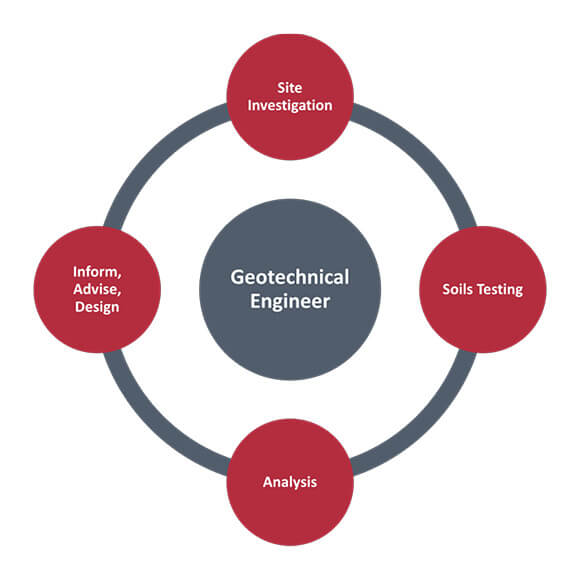The Facts About Geotheta Uncovered
The Facts About Geotheta Uncovered
Blog Article
Unknown Facts About Geotheta
Table of ContentsThe 3-Minute Rule for GeothetaGeotheta for DummiesThe 7-Minute Rule for GeothetaGetting My Geotheta To Work
They collaborate with civil engineers, architectural designers, engineers, and various other experts to integrate geotechnical factors to consider into the total task design and building and construction procedure. This requires reliable team effort, sychronisation, and communication to ensure that the geotechnical elements straighten with the project objectives and meet governing requirements.Mining & Products Engineering: Principles of boring, penetration rates, and elements impacting the option of exploration method. Qualities of nitroglycerins, shooting systems and blast patterns. Blasting techniques in surface and below ground functions. Special blasting strategies at excavation perimeters. Vibration and noise control. Mechanical and continuous techniques to fragmentation, consisting of longwall shearing and fullface boring.
Modelling of fragment and particle size distributions; comminution as a transfer feature. Comminution innovation: squashing, grinding, dimension classification. Integrated analysis of fragmentation and comminution procedures. Provided by: Mining & Products Engineering.
All About Geotheta
Bachelor's degree programs in civil, geotechnical, geological, and environmental engineering usually last 4 years and include general education and learning programs in English, social scientific research, and the humanities, in addition to training courses in advanced mathematics, structural geology, and fluid mineralogy. (https://geotheta.blog.ss-blog.jp/2024-08-02?1722614750)
Geotechnical design entails the assessment of the dirt and rock problems at a particular site, and their effects for the growth of that site. As the majority of structures depend on the ground for assistance, it is without surprise that a thorough understanding of the ground problems, and the suitability of structure systems, are crucial to the long-lasting security and efficiency of the structure or framework.
Specialising in the investigation of geological developments and ground behaviour, geotechnical designers do scientific examinations and screening to understand the influence these geological formations might have on the style and building of structure, civil and framework tasks. This proficiency is important for the style and building and construction of structures, roads, tunnels, dams, bridges, and supply of water and sewer system.
The geotechnical team at Douglas Allies consistently talk to engineers, style designers, designers, and contractors to make recommendations on layout and development proposals to guarantee that the constructed structures are appropriately made for the ground conditions. For example, the design of footing systems requires to take into consideration the weight of the structure, the ability of the ground to support that weight with each other with movement tolerances and reliable building and construction.
Getting The Geotheta To Work
This task is substantially streamlined by the usage of our Douglas Map geospatial system that makes this information easily easily accessible in a simple to use web internet browser user interface. A geotechnical designer will certainly direct the exploration of boreholes and examination pits to gather soil and various other samples, and also examine surface area functions and ground direct exposures to develop a geotechnical design of the subsurface conditions.
Relying on the job kind and ground problems experienced, laboratory testing may to name a few things evaluate strength, compressibility, reactivity and/or leaks in the structure of soil and rock samples. Hereafter data is gathered and collected, the outcomes are utilized for a geotechnical model more helpful hints of the site, which is normally presented as areas across the website.

A geotechnical investigation naturally can only assess the ground problems at the locations drilled or dug deep into. Natural variants in dirt and rock conditions can occur across a website and in between test places. It is as a result good technique that the geotechnical designer be retained throughout construction of the task to provide on-site verification that the ground problems experienced follow the assumptions and advice supplied in the geotechnical investigation report.
9 Easy Facts About Geotheta Shown
Geotechnical designers use their comprehensive knowledge of soil and rock to evaluate risk and solve problems on varied framework projectsGeotechnical engineering is a specialist branch of civil design which checks out the behaviour of planet materials and the application of dirt and rock technicians. Geo Tech Engineering. As a geotechnical engineer, you will certainly analyze the physical, mechanical and chemical properties of soil and rock in order to make foundations, maintaining frameworks and earthworks
Geotechnical design is closely connected to and overlaps with, both engineering geology and ground design - https://www.merchantcircle.com/blogs/geotheta-miami-fl/2024/8/Why-Geotechnical-Engineers-at-Geotheta-Are-Your-Best-Bet/2781881. It's possible to specialise in geotechnics or job for a geotechnical firm yet be referred to as an engineering geologist or a ground engineer. As a geotechnical designer, you'll require to: develop and preserve relationships with clients and other specialists associated with the site, throughout each projectmaintain safety and security criteria on site bear in mind expense implications when you make recommendationsstudy geological maps and airborne pictures from an array of resources and from different time periodsexamine building plans to see how feasible they are based upon your understanding of the siteinvestigate risks or geological hazards for the sitesearch for environmentally sensitive features, such as landfill begin to create accurate and interpretive ground modelsplan area investigationsdrill and analyse samples of bedrock, dirt, groundwater and extra products monitor various other specialists on sitesolve technical concerns as they emerge, such as unanticipated structures at drill sitesmonitor conditions during and after building to make certain structures are stable in the brief and lengthy termadding information collected on site to your preliminary researchcreating geotechnical calculations, illustrations, and two or three-dimensional computer models analyzing the datamaking referrals concerning the proposed usage of the site

Report this page